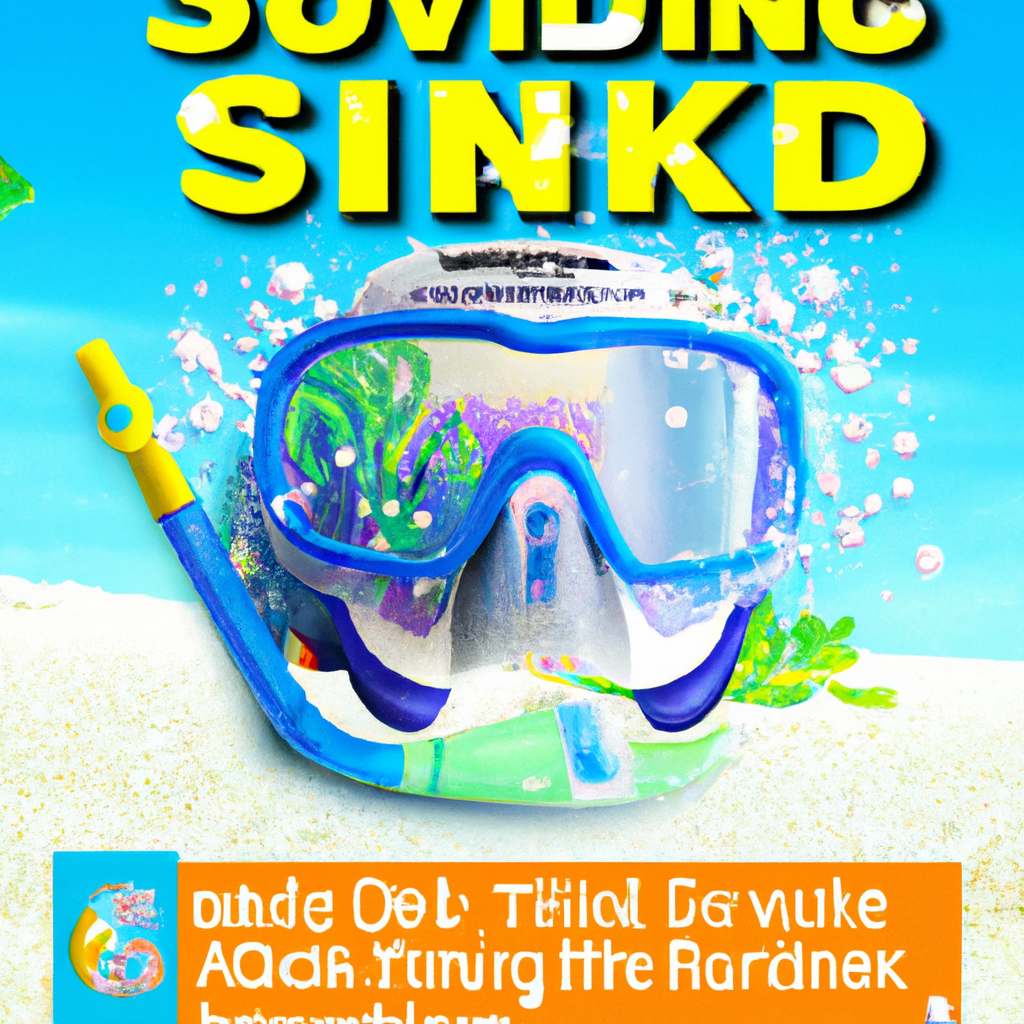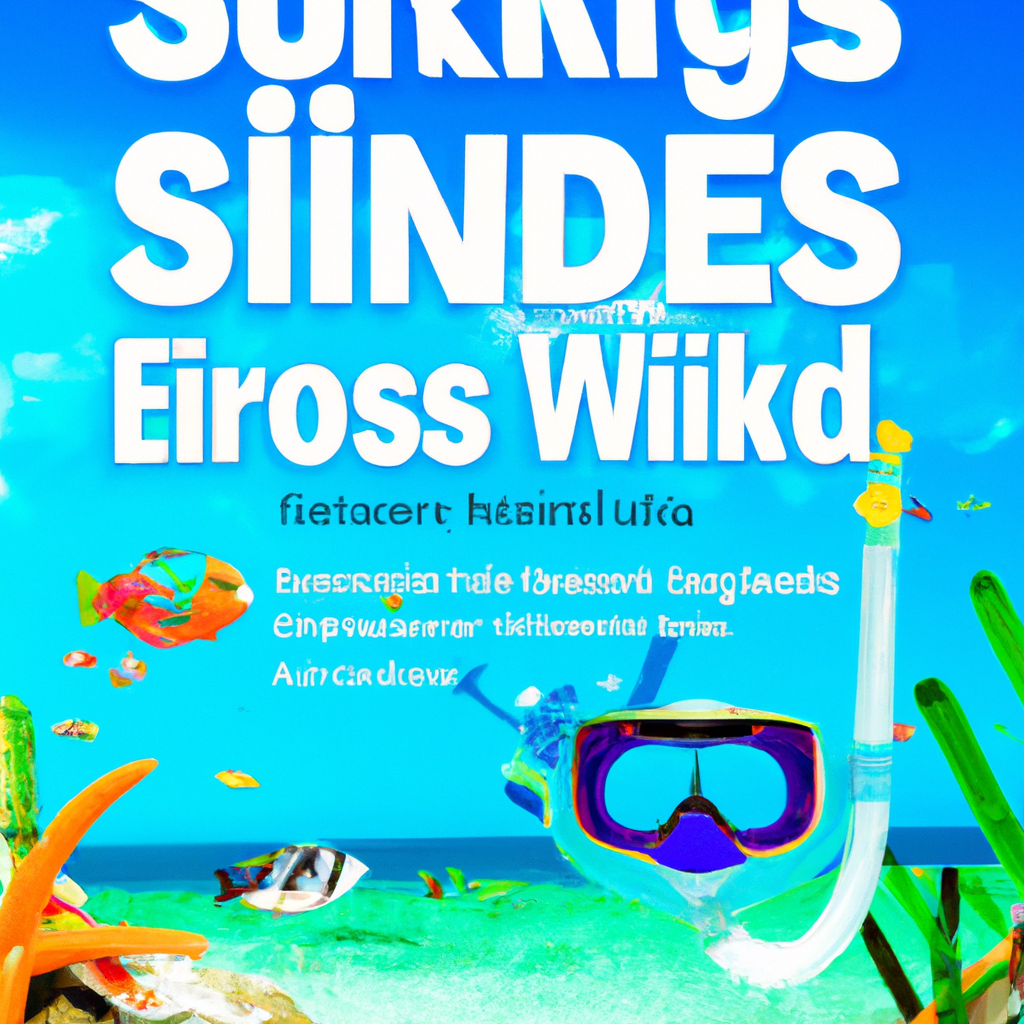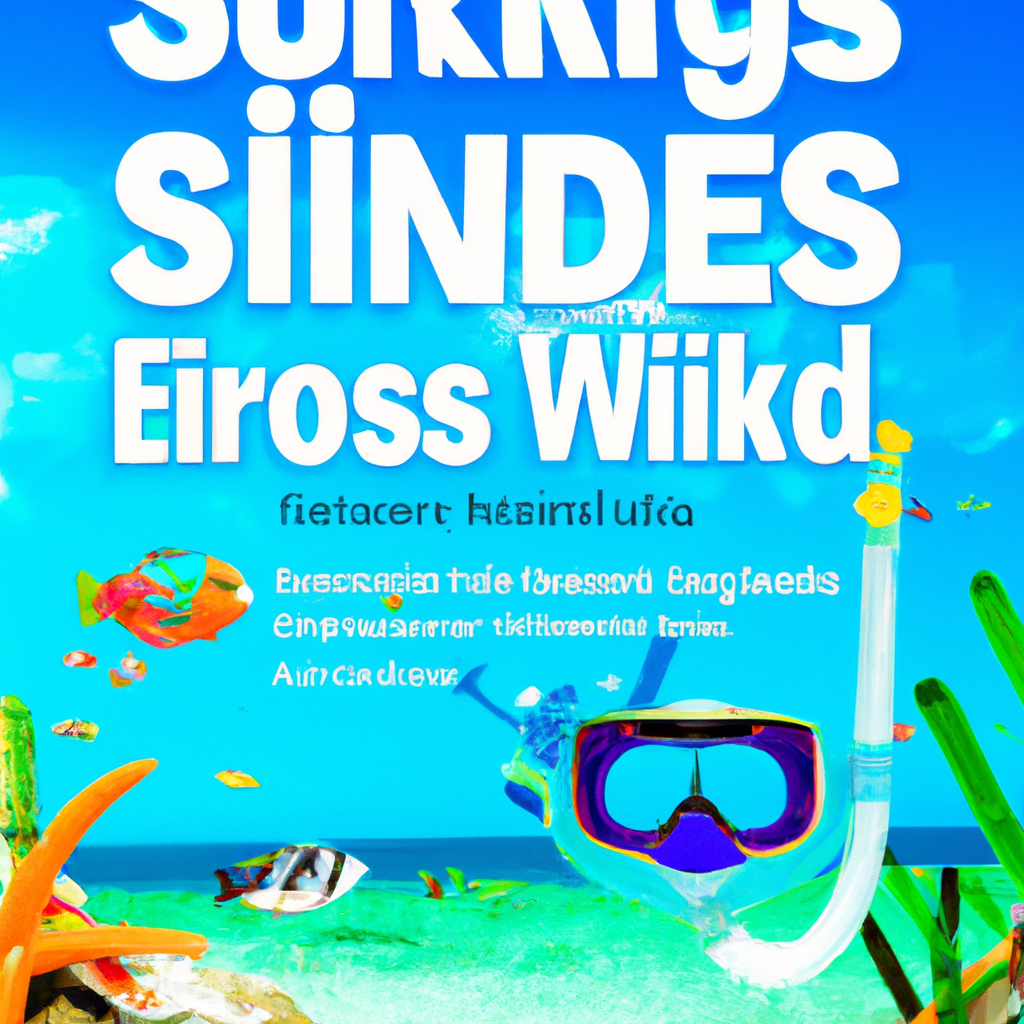So you’ve always been fascinated by the underwater world, but scuba diving seems a bit too daunting for you? Well, fear not, because snorkeling is the perfect activity for beginners who want to explore the underwater wonders. In this beginner’s guide to snorkeling, we will cover everything you need to know about this fun and accessible recreational activity. From choosing the right equipment to mastering the basic techniques, get ready to dip your toes into the world of snorkeling and discover the beauty that lies beneath the surface. Snorkeling can be an exciting and rewarding experience that allows you to explore the vibrant underwater world. Whether you’re a beginner or an experienced snorkeler, it’s essential to choose the right gear to enhance your comfort and safety in the water. From snorkel masks to fins, wetsuits, and additional equipment, here’s a comprehensive guide to help you choose the right snorkeling gear.
Choosing the Right Snorkeling Gear
Snorkel Mask
A snorkel mask is one of the most important pieces of gear for snorkeling. It should provide a comfortable fit and a watertight seal around your face. Look for a mask with a wide field of view and a tempered glass lens for durability. Consider mask features like a purge valve for easy clearing and a silicone skirt for a comfortable seal.
Snorkel Tube
The snorkel tube allows you to breathe while keeping your face submerged in the water. Look for a snorkel with a comfortable mouthpiece and a splash guard or dry top to prevent water from entering the tube. Some snorkels even feature a purge valve for easy clearing of water.
Snorkel Fins
Snorkel fins are designed to improve your swimming efficiency and help you navigate through the water effortlessly. Look for fins that fit snugly but comfortably on your feet. Consider the length and design of the fins for optimal propulsion and maneuverability. Closed-heel fins are suitable for snorkeling in calm waters, while open-heel fins offer adjustability and are ideal for different water conditions.
Wetsuit or Rash Guard
Depending on the water temperature, you may need a wetsuit or a rash guard to protect your skin and keep you warm in the water. A wetsuit provides thermal insulation and is suitable for colder water temperatures, while a rash guard offers sun protection and is more suitable for warmer waters. Consider the thickness of the wetsuit based on the water temperature you’ll be snorkeling in.
Additional Equipment
In addition to the necessary gear, you may also want to consider additional equipment to enhance your snorkeling experience. A snorkel vest can provide extra buoyancy and increase your confidence in the water, especially if you’re not a strong swimmer. A waterproof bag or dry case is essential to keep your valuables and electronics safe from water damage. And don’t forget a high-quality underwater camera to capture the stunning underwater moments.
Now that you have the right snorkeling gear, let’s dive into some techniques to help you get familiar with snorkeling and make the most out of your underwater adventure.
Getting Familiar with Snorkeling Techniques
Breathing Techniques
Proper breathing techniques are crucial for an enjoyable and relaxed snorkeling experience. Breathe slowly and deeply through your mouth using the snorkel tube. Practice breathing in a controlled manner to conserve energy and avoid hyperventilation. Remember to exhale fully to ensure efficient exchange of air.
Equalization Techniques
Equalization is necessary to alleviate pressure on your ears and sinuses as you descend into deeper water. To equalize, gently pinch your nostrils closed and exhale while keeping your mouth closed. This technique helps balance the pressure and prevents discomfort or potential injury.
Clearing Water from Snorkel
At times, water may enter your snorkel tube, disrupting your breathing. To clear the water, exhale forcefully through the snorkel with a sharp burst of air. This will expel the water from the tube and allow you to resume breathing normally.
Proper Positioning and Movement in Water
Maintaining a horizontal position and a streamlined body posture will help you move efficiently through the water. Stay relaxed and use long, slow kicks with your fins to propel yourself forward. Keep your arms relaxed at your sides or gently outstretched for balance.
Diving Techniques
Snorkeling isn’t just about staying at the surface. If you feel comfortable and confident, you can practice diving down to explore the underwater landscape. Take a deep breath, hold it, and gently kick downward while equalizing your ears. Remember to monitor your depth and be mindful of your limits.
With these snorkeling techniques in mind, it’s essential to prioritize safety while enjoying your underwater exploration.

Understanding Snorkeling Safety
Know the Swimming Requirements
Before embarking on a snorkeling adventure, it’s crucial to have basic swimming skills and be comfortable in the water. Snorkeling requires a certain level of physical fitness and confidence to ensure your safety and enjoyment.
Check Weather and Water Conditions
Always check the weather and water conditions before heading out for a snorkeling adventure. Avoid snorkeling during storms, strong currents, or when visibility is poor. Be aware of any local warnings or advisories that may affect snorkeling safety.
Snorkel with a Buddy
Snorkeling with a buddy is not only more enjoyable but also safer. Having a buddy allows you to watch out for each other and provide assistance if needed. It’s important to establish clear communication signals before entering the water and to stay vigilant throughout your snorkeling session.
Learn Basic First Aid for Snorkeling
Acquiring basic first aid knowledge specific to snorkeling can be extremely helpful in case of emergencies. Learn techniques like CPR, rescue breathing, and how to handle marine life encounters or injuries. Knowing how to respond promptly and confidently can make a significant difference in emergency situations.
Beware of Marine Life and Currents
While snorkeling, be aware of the marine life around you and respect their habitat. Avoid touching, harassing, or feeding any marine creatures for both your safety and the preservation of the ecosystem. Additionally, be cautious of ocean currents and avoid strong currents that could carry you away from your intended snorkeling area.
Now that you know how to stay safe while snorkeling, let’s explore some of the best snorkeling locations to make the most of your underwater adventures.
Choosing the Right Snorkeling Locations
Shallow Reefs and Lagoons
Shallow reefs and lagoons with calm waters are ideal for beginners and those looking for a relaxed snorkeling experience. These locations often boast an abundance of marine life and colorful coral formations, allowing you to explore the underwater world at your own pace.
Coral Gardens and Marine Reserves
Coral gardens and marine reserves offer some of the most diverse and breathtaking snorkeling experiences. These areas are protected, making them havens for a wide variety of marine species and vibrant coral reefs. Snorkeling in marine reserves also contributes to conservation efforts by supporting protected areas.
Clear and Calm Waters
When choosing an ideal snorkeling location, opt for clear and calm waters to maximize visibility and enjoyment. Crystal-clear waters allow for better visibility of marine life, coral formations, and other underwater features. Additionally, calm waters make snorkeling easier and more enjoyable, especially for beginner snorkelers.
Snorkeling from Shore vs. Boat
Consider whether you prefer snorkeling from the shore or from a boat. Shore snorkeling offers easy access and the flexibility to explore at your own pace. Boat snorkeling, on the other hand, allows you to reach more remote or offshore snorkeling spots, typically with the assistance of a guide or tour.
Consider Local Guides and Restrictions
If you’re unfamiliar with a snorkeling area, consider hiring a local guide or joining a snorkeling tour. Local guides have in-depth knowledge of the area’s marine life, currents, and conditions, enhancing your snorkeling experience. Additionally, be mindful of any snorkeling restrictions or regulations in place to protect the fragile marine environment.
Now that you’ve chosen the perfect snorkeling destination, it’s time to prepare yourself physically and mentally for your underwater adventure.

Preparing for Your Snorkeling Adventure
Physical Fitness and Health
Ensure your physical fitness and overall health are in good condition before snorkeling. Swimming regularly, practicing cardiovascular exercises, and maintaining a healthy lifestyle will enhance your endurance and enjoyment in the water. If you have any pre-existing medical conditions, consult with your healthcare provider before snorkeling.
Sun Protection and Skin Care
Protecting your skin from the sun’s harmful rays is crucial while snorkeling. Apply a waterproof sunscreen with a high SPF to exposed areas of your body, including your face and neck. Wear a wide-brimmed hat, sunglasses, and consider using a rash guard or wetsuit to provide additional sun protection.
Hydration and Nutrition
Hydration is essential for a safe and enjoyable snorkeling experience. Drink plenty of water before, during, and after snorkeling to prevent dehydration. Additionally, fuel your body with nutritious foods that provide sustained energy, such as fruits, vegetables, and whole grains.
Basic Swimming Skills Practice
To build your confidence in the water and improve your swimming abilities, practice basic swimming skills regularly. This includes floating, treading water, and different swimming strokes. Enrolling in swimming lessons or joining a water fitness class can help you develop and refine your skills.
Researching the Snorkeling Spot
Before heading to your chosen snorkeling spot, conduct thorough research to familiarize yourself with the area. Learn about the marine life you might encounter, the potential snorkeling hazards, and any specific snorkeling guidelines. Being well-informed will help you make the most of your snorkeling adventure.
Now that you’re physically and mentally prepared, it’s time to master the essential snorkeling techniques to make your underwater experience even more enjoyable.
Mastering Snorkeling Techniques
Practice Proper Breathing
Take the time to practice proper breathing techniques before your snorkeling adventure. Practice inhaling and exhaling slowly through your mouth while using your snorkel. Get comfortable with the rhythm and technique so that when you’re in the water, it becomes second nature.
Practice Clearing Water from Snorkel
During your practice sessions, make sure to practice clearing water from your snorkel. Simulate water entering your snorkel by intentionally submerging it and then practice forcefully exhaling to clear the water. This skill will come in handy if water enters your snorkel while snorkeling.
Understand Equalization Techniques
Equalization is an important skill to master, especially if you plan on diving or exploring deeper waters. Practice equalizing your ears by gently pinching your nostrils closed and exhaling while keeping your mouth closed. With practice, you’ll be able to equalize comfortably as you descend into the depths.
Improve Swimming Technique
Efficient swimming technique will enhance your snorkeling experience by allowing you to move easily through the water. Work on your kicking technique, body positioning, and overall swimming efficiency. You can take swimming lessons or practice drills to improve your swimming skills.
Efficient Use of Fins
Fins are a valuable tool for propulsion and maneuverability in the water. Practice using your fins efficiently by employing long, slow kicks from your hips. This will help you maintain a steady pace and conserve energy during your snorkeling adventures.
Despite your best efforts, you might encounter certain issues while snorkeling. Here are some common issues and how to deal with them.
Dealing with Common Snorkeling Issues
Mask Leaks and Fogging
Mask leaks and fogging can disrupt your visibility and overall snorkeling experience. To prevent leaks, ensure your mask is properly fitted before entering the water. If your mask leaks or fogs up during snorkeling, return to the surface, re-adjust the mask, and defog it using an anti-fog solution or spit.
Snorkel Mouthpiece Discomfort
If you experience discomfort from your snorkel mouthpiece, it might be due to an improper fit or irritation from prolonged use. Try adjusting the position of the mouthpiece or consider using a different mouthpiece with a better fit. Taking breaks and removing the snorkel can also provide relief.
Feeling Claustrophobic
Feeling claustrophobic in the water can be a common issue, especially for beginner snorkelers. To overcome this feeling, practice snorkeling in calm, shallow areas first. Focus on controlled breathing and relaxation techniques. Gradually increase your comfort level by snorkeling with a buddy or in a group.
Cramping and Fatigue
Cramping and fatigue can occur due to muscle strain or prolonged exertion in the water. Before snorkeling, make sure to properly warm up your muscles and stretch. If you experience cramping while snorkeling, stop, relax, and gently stretch the affected muscles. Stay hydrated and avoid overexertion.
Dealing with Anxiety or Fear
Anxiety or fear can be common when snorkeling, especially if you’re not accustomed to being in the water or encountering marine life. Take things at your own pace, practice relaxation techniques, and find comfort in snorkeling with a buddy or joining guided tours. Over time, you’ll become more comfortable and confident in the water.
As responsible snorkelers, it’s crucial to be mindful of the environment and adhere to snorkeling etiquette to preserve the fragile underwater ecosystems.
Environmental Responsibility and Snorkeling Etiquette
Respect Marine Life and Coral
Always maintain a respectful distance from marine life and avoid touching or disturbing anything underwater. Do not remove or collect any corals, shells, or marine creatures. Remember that you are a guest in their home and should observe and admire without causing harm.
Avoid Touching or Disturbing Anything
To minimize your impact on the marine environment, avoid touching or standing on the coral reef. Even slight contact can cause significant damage to these delicate ecosystems. Be cautious with your movements and swim with care to avoid unintentionally damaging the coral or stirring up the sediment.
Use Reef-Friendly Sunscreen
Traditional sunscreens can contain harmful chemicals that can harm coral reefs and marine life. Choose reef-friendly sunscreens that are labeled as biodegradable and free of oxybenzone and octinoxate. These sunscreens are formulated to minimize their impact on the environment while still providing sun protection.
Do Not Feed Marine Animals
Feeding marine animals disrupts their natural diet and behavior and can harm their overall health. Avoid feeding fish, turtles, or any other marine creatures you encounter while snorkeling. Instead, appreciate their natural feeding patterns and observe their behavior from a respectful distance.
Follow Local Regulations and Guidelines
Each snorkeling destination may have specific regulations and guidelines to protect the marine environment. Familiarize yourself with these rules before entering the water and ensure you follow them diligently. These regulations aim to protect the fragile ecosystems and ensure that future generations can enjoy and appreciate them too.
Underwater photography and videography can be a fantastic way to capture and share your snorkeling adventures. Here’s a guide to help you get started.
Capturing Memories: Underwater Photography and Videography
Choosing the Right Equipment
Underwater photography and videography require specialized equipment that can withstand water pressure and deliver stunning results. Invest in a waterproof camera or a housing for your camera that is specifically designed for underwater use. Consider factors like resolution, lens options, and ease of use when selecting your equipment.
Mastering Underwater Photography Basics
Before diving into underwater photography, familiarize yourself with the basics of composition, lighting, and camera settings. Learn how to position yourself and your subject, utilize natural light, and adjust exposure settings to capture stunning underwater images. Practice in controlled, shallow waters to refine your skills.
Composition and Lighting Tips
Composition and lighting play a crucial role in capturing captivating underwater images. Utilize natural light by snorkeling in well-lit areas and shooting during the golden hours of the day. Experiment with different angles, perspectives, and focal points to create visually appealing photographs.
Post-Processing and Sharing
Once you’ve captured your underwater shots, post-processing can further enhance the quality and impact of your images. Utilize photo editing software to adjust exposure, colors, contrast, and sharpness. When sharing your snorkeling memories, consider social media platforms, photo sharing websites, or creating a personal photo album to showcase your adventures.
To expand your knowledge and further enhance your snorkeling skills, here are some additional resources to explore.
Snorkeling Resources and Further Learning
Snorkeling Courses and Certification
Consider enrolling in snorkeling courses or obtaining certification from recognized organizations. These courses provide comprehensive training on snorkeling techniques, safety protocols, and environmental conservation. Certification can enhance your skills and open up opportunities for more advanced snorkeling adventures.
Online Resources and Communities
The internet is a treasure trove of information and resources for snorkelers. Explore online websites, forums, and social media groups dedicated to snorkeling. Engage with fellow snorkelers and experts to gain insights, share experiences, and stay updated on the latest trends and destinations.
Snorkeling Guidebooks and Manuals
Guidebooks and manuals specific to snorkeling can provide valuable information on destinations, snorkeling spots, and techniques. These resources often include detailed maps, descriptions of marine life, tips, and insider knowledge. Research and choose guidebooks that align with your interests and snorkeling aspirations.
Snorkeling Workshops and Retreats
Snorkeling workshops and retreats offer immersive and educational experiences designed to enhance your skills and knowledge. These programs are typically led by experienced snorkelers or professionals who provide hands-on coaching and guidance. Consider joining a workshop or retreat to accelerate your learning and meet like-minded snorkelers.
Snorkeling Equipment Maintenance
Proper maintenance of your snorkeling equipment is essential to ensure its longevity and optimal performance. Rinse your gear thoroughly with freshwater after each use to remove saltwater and debris. Store your gear in a cool, dry place away from direct sunlight to prevent damage. Regularly inspect your equipment for any signs of wear and tear, and replace or repair as needed.
Snorkeling has the potential to unlock a whole new world beneath the surface of the water. By choosing the right gear, mastering snorkeling techniques, prioritizing safety, selecting the best locations, preparing adequately, and being environmentally responsible, you can embark on unforgettable snorkeling adventures. With practice, patience, and a sense of wonder, you’ll create incredible memories and develop a lifelong passion for exploring the wonders of the underwater realm. So grab your gear, dive in, and immerse yourself in the beauty and tranquility of the underwater world. Happy snorkeling!
